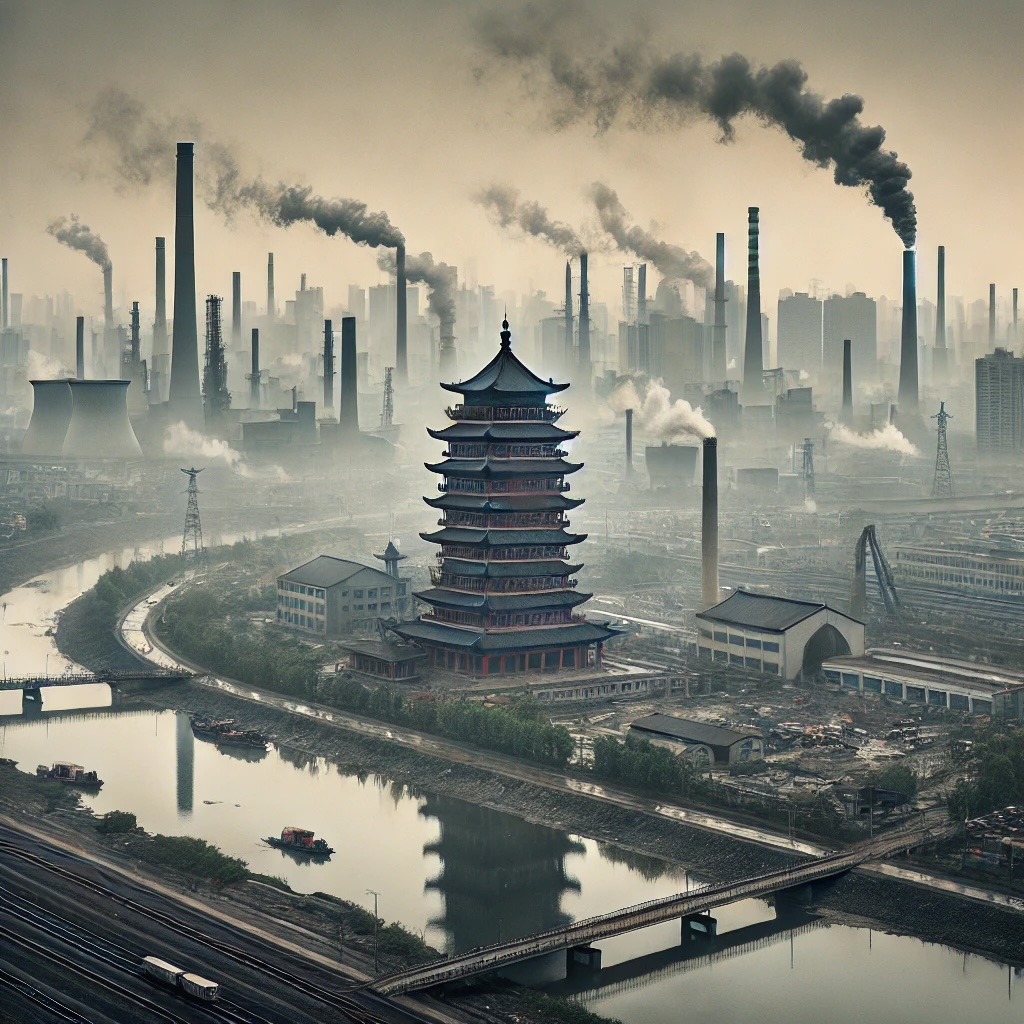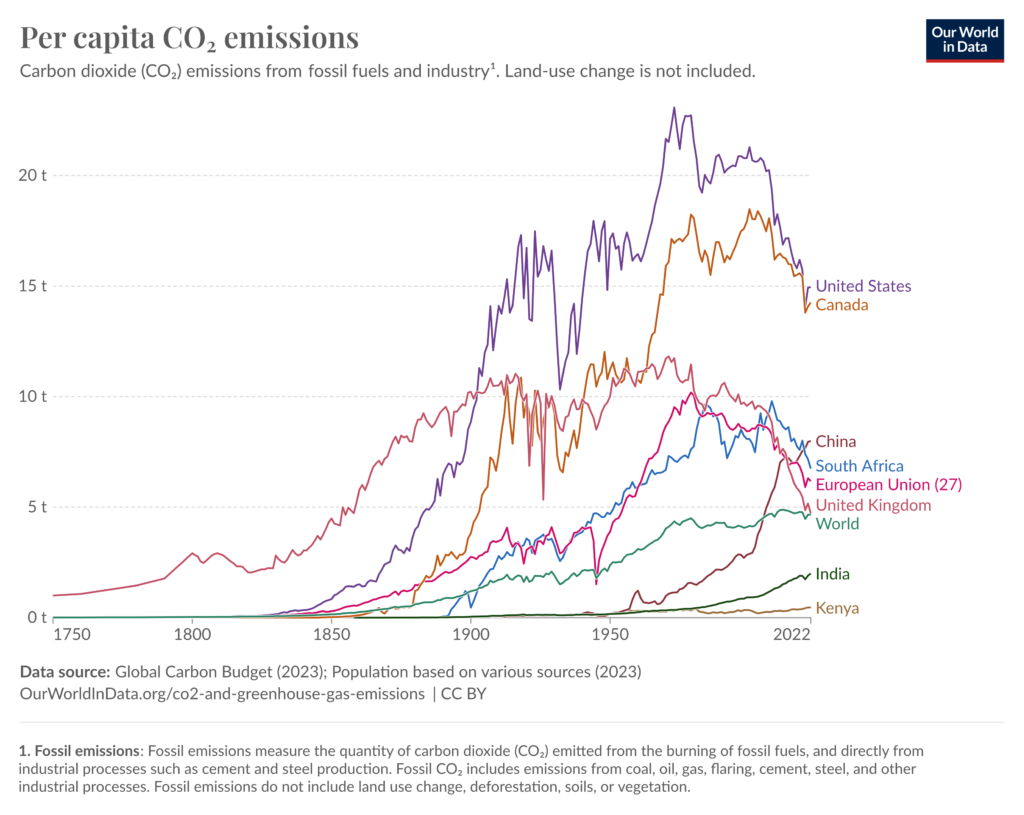One of the common objections I hear when I tell others of my mission to bring awareness and help reverse our climate emergency has to do with the unfairness of the west having to find a solution. Some people seem to think there’s no point in even trying, as the US and other western countries aren’t even the biggest emitters: “Why should we change our habits? It’s really China and India that are the problem.” Here’s why this argument does not stand up to scrutiny:
Our Climate Emergency is Not China’s Fault: A Global Perspective
When discussing the climate crisis, it’s easy to point fingers and place blame on certain countries for the dire situation we find ourselves in today. China, being the world’s largest emitter of carbon dioxide, often becomes the scapegoat in these conversations. “Why should we change our lifestyle when China is the problem?”
However, while it’s undeniable that China plays a significant role in global emissions, laying the blame solely at their feet ignores the complexity of the issue and the collective responsibility that all nations, especially those in the West, share in this ongoing emergency.

Historical Context: The Roots of the Problem
To fully understand the climate crisis, let’s look at its historical roots. The industrial revolution, which began in Europe and North America in the late 18th century, marked the beginning of massive greenhouse gas emissions. For over two centuries, Western nations have built their economies on fossil fuels, leading to unprecedented economic growth.
With that growth has also come the degradation of our planet’s environment: CO2 emissions have skyrocketed beyond what our natural mechanisms can cope with. The waste associated with this growth has dumped unprecedented amounts of toxins into our water, air and soil.
The United States, with 4% of the world’s population, is responsible for approximately 25% of all historical CO2 emissions. European countries also have a significant share of historical emissions. This legacy of environmental degradation brought on by a highly consumptive lifestyle has set the stage for the current climate crisis.
China’s Role: Rapid Development in a Globalized Economy
China’s rise as an economic superpower has been rapid, and with it has come an increase in carbon emissions. However, this growth must be seen within the context of global economic dynamics. Much of China’s emissions can be attributed to its role as the “world’s factory.” Western countries have outsourced their manufacturing to China, effectively offshoring their emissions. The goods consumed in the West are often produced in China, meaning that while the emissions are counted against China’s total, they are a direct result of Western consumption patterns. When we take exported goods out of the picture, China’s emissions drop 14% according to a University of Michigan study in 2020. (Not clear if that’s a full accounting of all emissions. This is likely a conservative estimate of how much the emissions in China would drop.)

Moreover, China’s population of 1.4 billion people means that though the country is the largest emitter in absolute terms, its per capita emissions are still lower than those of many Western nations. ** In 2021, the average American emitted about 14.2 metric tons of CO2 per capita, whereas the average Chinese citizen emitted approximately 7.1 metric tons.** This stark difference highlights the disparity in individual contributions to global emissions and underscores the importance of considering per capita figures when assessing responsibility.
Global Supply Chain: A Shared Responsibility
In our interconnected world, the climate crisis cannot be attributed to one nation alone. The global supply chain links the production and consumption of goods across borders, making it a shared responsibility. The demand for cheap goods in Western countries has driven the high levels of industrial activity in China, contributing to its emissions. Additionally, multinational corporations headquartered in the West often dictate production practices in China, further complicating the issue of accountability.
China’s Efforts Towards a Greener Future
It is also important to recognize that China is taking significant steps to address its environmental impact. The country is a global leader in renewable energy production, investing heavily in solar, wind, and hydroelectric power. China has also set ambitious targets for carbon neutrality, aiming to achieve carbon neutrality by 2060. These commitments reflect China’s awareness of its role in the global climate crisis and its efforts to contribute to the solution.
The Role of Western Nations: Leading by Example
While China’s role in the climate crisis is often emphasized, Western nations must acknowledge their historical responsibility. This means not waiting until China’s total GHG emissions are down to a level considered fair and “doing their part”. It means recognizing their own culpability that the Western consumptive way of life is the main driver of climate change.
Western countries must also address their consumption patterns, which drive much of the global emissions. This includes shifting towards a circular economy, reducing waste, and prioritizing sustainability in every aspect of life.

Conclusion: A Collective Challenge, A Collective Solution
The climate crisis is a global emergency that requires a global response. Blaming China for the climate emergency, or waiting until China’s improvements seem ample enough for the west to even make an effort is not only unfair but also counterproductive. It distracts from the real issue: the need for collective action. Every nation, especially those with a history of high emissions, has a responsibility to address this crisis.
The focus in addressing our climate emergency should be on cooperation, innovation, and shared responsibility. By working together, all countries can contribute to a sustainable future where economic development and environmental stewardship go hand in hand. Our planet’s future depends on it.
—
**References:**
– Historic Responsibility for Climate Change (https://www.theguardian.com/environment/2014/apr/21/countries-responsible-climate-change)
– China’s Emissions and the Global Economy(https://www.carbonbrief.org/china-briefing-chinas-declining-coal-consumption-climate-action-and-carbon-footprint)
– Per Capita Emissions Data(https://ourworldindata.org/co2-and-other-greenhouse-gas-emissions#annual-co2-emissions-per-capita)
– China’s Renewable Energy Leadership(https://www.worldbank.org/en/news/feature/2020/06/29/how-china-is-leading-the-way-to-a-green-energy-future)
-Climate Denier’s Playbook podcast. Episode “But What About China?” from Nov 1, 2023.
This blog post was inspired by the ongoing dialogue about global climate responsibility and the importance of a nuanced, fair approach to addressing this urgent issue.

